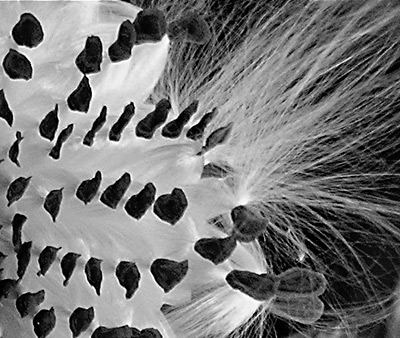 |
| Milkweed seeds. English photo. |
By Jean English, Editor, The Maine Organic Farmer & Gardener
Every fall when our children were young, my husband would collect milkweed pods from a thousand-square-foot patch of Asclepias syriaca that grows on our land and store the seedpods in a paper bag over winter. In spring, when the swallows returned, he and the kids would scatter the parachuted seeds from our second-story deck, anticipating that the swallows would use some of the silken fluff in their nests.
I wrote about this family tradition in The MOF&G seven years ago (www.mofga.org/Default.aspx?tabid=755). Our kids have grown and scattered, like milkweed fluff, yet my husband still collects the pods. So when new neighbors with three young children visited this winter, he gave them the bag of pods, enthusiastically instructing them about scattering the seed in spring.
That scattering has always been a joy for us, but after last summer’s lack of monarch (and other) butterflies here, supporting milkweed and other plants for bees, butterflies and other wildlife is even more critical.
A December 20, 2013, article in The New York Times (“Setting the Table for a Regal Butterfly Comeback, With Milkweed,” by Michael Wines) points out that milkweed, the only food source for monarch butterfly caterpillars, is now rare in and around herbicide-treated cropland.
Wines writes, “The number of monarchs that completed the largest and most arduous migration this fall, from the northern United States and Canada to a mountainside forest in Mexico, dropped precipitously, apparently to the lowest level yet recorded.” He points to drought, bad weather and illegal logging in parts of Mexico as causes – and to loss of habitat in the Midwest and the Great Plains as land has been taken out of conservation and put into corn. Use of corn for ethanol has increased demand and prices for the crop, so more corn has been planted – almost all genetically engineered to resist the herbicide glyphosate (the active ingredient in Roundup). Applying glyphosate in and around corn (and soybean) fields has eliminated milkweed that once grew there.
Wines quotes biologist Dr. Laura Jackson of the University of Northern Iowa, who also directs UNI’s Tallgrass Prairie Center: “I can drive five hours east, five hours north, five hours south, five hours west and see nothing – nothing – but corn and soybeans.”
Our small milkweed patch provides not just essential food for monarch larvae, but its flowers support numerous pollinators; its root system holds soil; its growth sequesters carbon; its fragrance fills the air on warm summer days. This remarkable plant has been used for fiber, insulation (the fluff), wild food (young shoots) and more. We could likely replace some U.S. corn acreage with milkweed and other pollinator plants and at the same time benefit our health (less corn syrup, less corn-fed beef, less herbicide and nitrogen runoff, less pollution in the Gulf of Mexico…). So, one step: Don’t buy genetically engineered corn products.
We can also plant for pollinators far and wide. We can transform monoculture lawns at our homes, workplaces and parks to wildflower meadows (even incorporating clover in a lawn can help) and encourage utility companies and transportation departments to plant pollinator-friendly species along rights-of-way and not to mow them when flowering.
Monarch Watch (www.monarchwatch.org/) is an excellent resource for information and locally adapted Asclepias seed.
